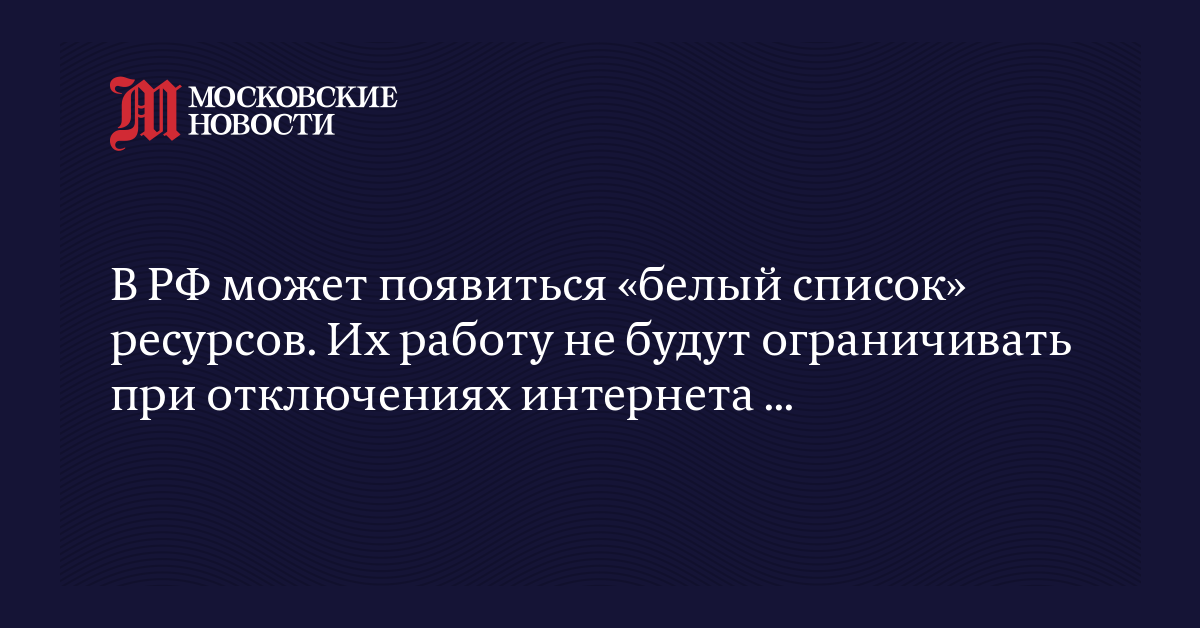The plan for mobile internet operation during network shutdowns amid drone attacks has not yet been approved by the FSB. Several options for internet access during mobile network shutdowns are being considered. Meanwhile, the Ministry of Digital Development has agreed with telecom operators on a scheme for mobile internet access during blackouts.
- The system is expected to operate based on “CAPTCHA” (a test to determine whether the user is a bot or a human) and “whitelists” (resources such as marketplaces, delivery services, taxis, etc.). M2M networks (Internet of Things) will function separately. Foreign SIM cards will not be active in Russia for the first 5 hours after crossing the border (also a security measure against drones).
- The system will use DPI (deep packet inspection) technology. Data transmission will be blocked for all protocols and ports except for a specific list. DPI also allows for traffic analysis and differentiation.
- The list of available services is still being coordinated with relevant agencies.
- Mobile operators are generally prepared to implement the new solutions.
- According to experts, permitted services may experience peak disruptions under heavy load. Errors in managing whitelists could also result in a “white-listed” resource being unavailable during critical moments. Additionally, automated CAPTCHA bypass techniques are widely available.
Furthermore, the Ministry of Digital Development has introduced requirements for satellite operators in organizing 5G connectivity. Operators may be required to monitor 5G device traffic when connected to satellite networks. Ground stations are planned to be equipped with relevant systems (SOMP and TPSU). The ministry believes that direct 5G device connections to foreign satellite networks could create an uncontrolled communication channel, posing a risk to national stability.
CAPTCHA
CAPTCHA (Completely Automated Public Turing test to tell Computers and Humans Apart) is a security measure designed to distinguish human users from bots by presenting challenges, such as distorted text or image recognition tasks. Developed in the early 2000s by researchers at Carnegie Mellon University, it was originally used to prevent automated spam and abuse on websites. Over time, CAPTCHA evolved into reCAPTCHA, which also helped digitize books and improve AI training by utilizing human input.
whitelists
“Whitelists” typically refer to approved lists of items, such as email addresses, websites, or applications, deemed safe or permitted in a system. Historically, the concept emerged in computing and cybersecurity to filter trusted entities, contrasting with “blacklists” that block unwanted elements. Over time, whitelisting has expanded into various fields, including cultural and media curation, where it signifies endorsed or prioritized content.
M2M networks
M2M (Machine-to-Machine) networks are communication systems that enable devices to exchange data autonomously without human intervention. These networks have evolved with advancements in IoT (Internet of Things) technology, allowing seamless connectivity between sensors, machines, and systems for applications like smart cities, industrial automation, and healthcare. Historically, M2M emerged in the early 2000s with cellular and wireless technologies, later expanding with 5G and AI to support real-time, large-scale data exchange.
DPI
“DPI” could refer to several entities, but if you mean the **Dunhuang Research Institute (Dunhuang Academy or DPI)** in China, it is a leading institution dedicated to the preservation and study of the Mogao Caves, a UNESCO World Heritage Site. Established in 1944, the DPI focuses on conserving the ancient Buddhist art, murals, and manuscripts found in these caves, which date back over a millennium. Its work is vital to understanding Silk Road history and cultural exchange.
If you meant a different “DPI,” please provide more context for a precise summary!
SOMP
“SOMP” likely refers to the **School of Military Police (SOMP)**, a training institution for military police in various countries, such as India or Brazil. In India, for example, the SOMP in Bengaluru trains personnel in law enforcement, security, and combat duties, playing a key role in military discipline. Its history is tied to the development of military policing in the respective armed forces, ensuring order and justice within the ranks.
If you meant a different “SOMP,” please provide additional context for a more accurate summary!
TPSU
There is no widely recognized cultural or historical site known as “TPSU.” It may refer to an abbreviation, a local term, or a lesser-known institution. If you have more context or details, please provide them so I can offer a more accurate summary.
5G
“5G” refers to the fifth generation of mobile network technology, which began global deployment around 2019. It offers significantly faster speeds, lower latency, and greater connectivity than previous generations (like 4G), enabling advancements in IoT, smart cities, and augmented reality. While not a physical site, 5G represents a major cultural and technological shift in communication and digital infrastructure.
Internet of Things
The **Internet of Things (IoT)** refers to the network of interconnected physical devices—such as smart appliances, wearables, and sensors—that collect and exchange data via the internet. Emerging in the late 20th century with advancements in wireless technology and miniaturized computing, IoT has transformed industries, homes, and cities by enabling automation and real-time data analysis. Today, it plays a key role in smart infrastructure, healthcare, and environmental monitoring, though concerns about privacy and security remain.




